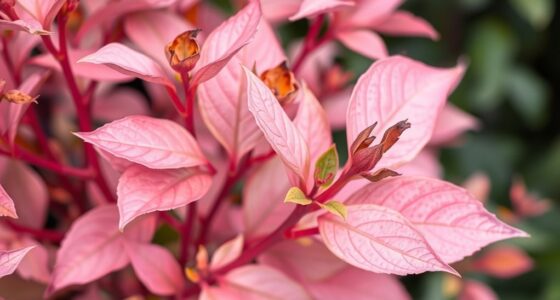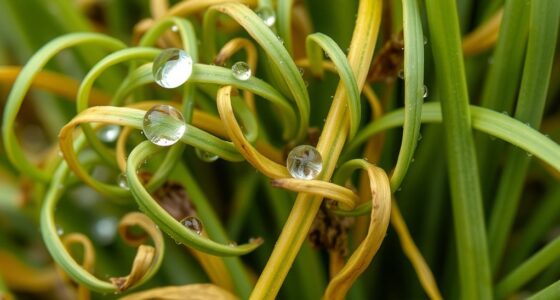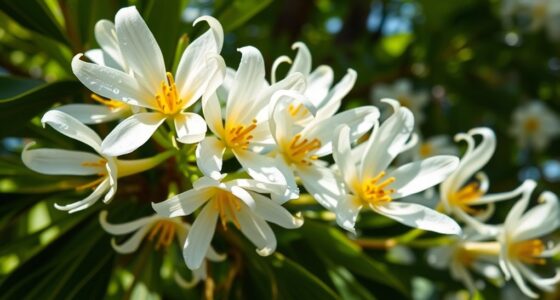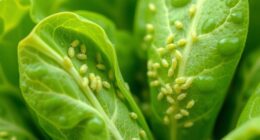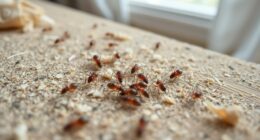Pink Muhly Grass turning brown in winter is usually a normal part of its seasonal cycle as it enters dormancy, especially with colder temperatures and shorter days. However, if the browning is uneven, soft, or accompanied by spots or mold, it could indicate disease or environmental stress like poor drainage or pests. Understanding the difference helps you care for your plant properly. Keep exploring to learn how to distinguish natural changes from problems and protect your muhly grass effectively.
Key Takeaways
- Brown or fading foliage in winter is typically a natural part of Pink Muhly Grass’s dormancy cycle.
- Sudden, uneven browning or soft, mushy areas may indicate pests, disease, or environmental stress.
- Cold temperatures and lack of protection often cause browning without sign of disease.
- Proper pruning, mulching, and watering support healthy winter resilience and prevent disease.
- Recognizing normal seasonal changes helps avoid unnecessary interventions and promotes healthy plant recovery.
Understanding Pink Muhly Grass and Its Seasonal Changes

Pink Muhly Grass, known for its fluffy, vibrant pink plumes, is a popular ornamental grass that adds visual interest to gardens. As seasons change, you’ll notice it shifting from lively pink to browning or dying back. To manage this, you should perform winter pruning, removing dead or damaged foliage to encourage healthy growth in spring. Fertilizer application is also key; apply a balanced, slow-release fertilizer in early spring to promote strong root development and vibrant plumes. Avoid over-fertilizing in late fall, as this can stimulate unwanted growth or disease. Understanding these seasonal changes helps you maintain a healthy, attractive plant year-round. Proper pruning and fertilizing ensure your Muhly Grass remains resilient and visually appealing through its natural seasonal cycle. Additionally, seasonal maintenance practices like mulching can help protect the plant roots during cold months and support overall health. Incorporating proper watering during dry periods also helps sustain the plant’s vitality throughout the year. Recognizing the plant’s natural dormancy cycle can also help prevent unnecessary interventions that might harm its health.
Recognizing Normal Winter Browning in Muhly Grass
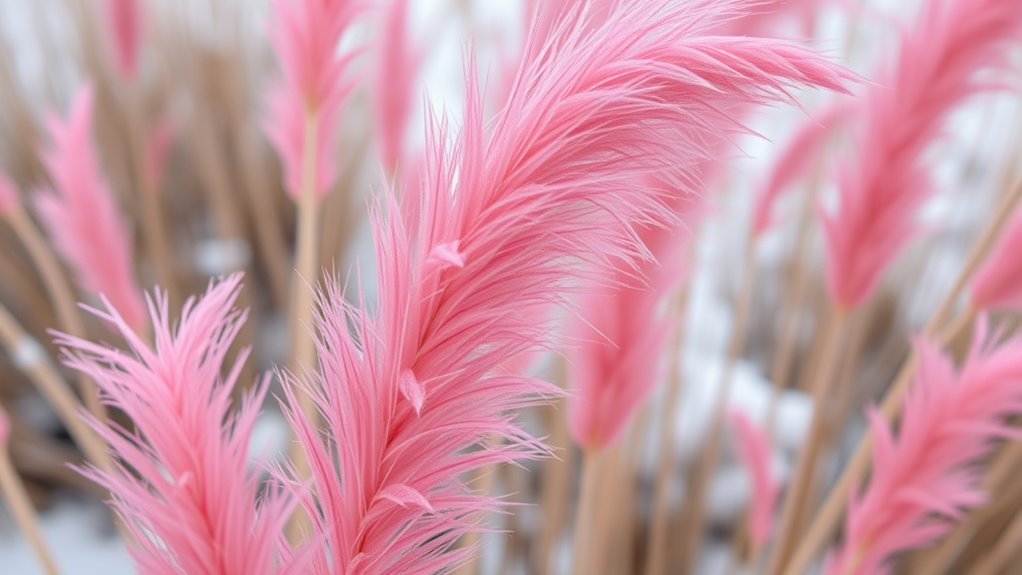
During winter, it’s normal for pink muhly grass to turn brown or fade in color. This change is part of the plant’s natural cycle and doesn’t mean it’s dying. Recognizing these seasonal color shifts helps you know when browning is simply a normal part of winter. Understanding plant cycles can help differentiate between natural seasonal changes and signs of disease or damage. Additionally, maintaining awareness of home environment factors can influence how the grass responds during colder months. Proper plant care practices during winter can further support its health and resilience through seasonal changes.
Seasonal Color Changes
As winter approaches, it’s normal for muhly grass to develop brown or tan hues in its foliage. During the seasonal shift, pink muhly’s vibrant pink plumes fade, leaving behind a softer, more muted appearance. This color change is part of the plant’s natural cycle, signaling a period of dormancy. You might notice the grass’s stems turning brown, especially after the flowering season ends. Keep in mind that this browning isn’t necessarily a sign of trouble; it’s a typical response to colder temperatures and shorter days. Understanding this seasonal color change helps you distinguish between healthy browning and potential problems. The browning can also be attributed to seasonal color changes, which are a normal part of the plant’s adaptive process. Embracing these natural shifts allows you to appreciate muhly grass’s beauty, even in its more subdued, winter-ready state.
Natural Plant Cycle
Recognizing the natural cycle of muhly grass helps you understand why browning occurs in winter. During this time, it’s normal for the foliage to turn brown or fade, as the plant conserves energy. This seasonal change isn’t a sign of disease but part of its dormancy process. Proper fertilizer application in early spring can support healthy growth, but avoid overdoing it in winter, which can lead to unnecessary stress. Pest control isn’t usually needed during dormancy, but keep an eye out for pests that might overwinter on the grass. Additionally, understanding plant dormancy can help you better care for muhly grass during colder months. By understanding this natural cycle, you prevent unnecessary concern and ensure your muhly grass remains healthy. This knowledge helps you distinguish between normal browning and potential problems requiring intervention. Being aware of plant health indicators further assists in identifying when action may be necessary.
Common Diseases That Cause Browning in Pink Muhly Grass

Several common diseases can cause pink muhly grass to turn brown, often signaling underlying health issues. Pest infestations, such as aphids or mites, can weaken the plant, leading to browning and dieback. These pests feed on the grass’s sap, causing stress and making it more vulnerable to disease. Nutrient deficiencies, particularly lacking nitrogen or potassium, also contribute to browning leaves and poor overall health. When the plant doesn’t receive essential nutrients, its growth stalls, and it becomes more susceptible to fungal infections. Fungal diseases like rust or leaf spot can cause brown patches and spots on the grass, further deteriorating its appearance. Recognizing these issues early helps you address pests and deficiencies before they cause irreversible damage. Understanding the importance of soil health and nutrients can help prevent many of these problems and promote healthier growth. Additionally, maintaining proper watering practices ensures the grass stays resilient against environmental stressors. Proper soil drainage is also crucial to prevent waterlogging, which can exacerbate fungal problems and root rot.
Environmental Factors Contributing to Browning and Dieback

Cold temperatures can stress your pink muhly grass, causing browning and dieback. If the soil is too dry or too wet, it can also weaken the plant and lead to browning spots. Understanding these environmental factors helps you keep your grass healthy and vibrant. Additionally, improper watering practices can exacerbate stress and promote browning. Using the correct soil drainage techniques can help prevent water-related issues that contribute to browning. Recognizing the importance of plant resilience can guide you in selecting suitable conditions and care routines to support your grass through seasonal changes.
Cold Temperature Effects
When temperatures drop unexpectedly, pink muhly grass can quickly show signs of stress, with browning and dieback often occurring at the tips. Cold temperatures can damage the grass’s tender foliage, especially if it’s not protected. To minimize this, avoid winter pruning, which can remove natural insulation and expose more vulnerable growth points. Instead, apply mulch insulation around the base to help retain soil warmth and protect roots from freezing. Cold stress causes moisture loss and cellular damage, leading to browning. You can also shield the plants with a frost cloth during severe cold snaps. Proper winter care reduces the risk of dieback caused by cold temperatures, ensuring your pink muhly grass stays healthy and vibrant through winter. Additionally, understanding plant cellular response to cold can help you implement more effective protective measures. Recognizing how cold temperatures affect plant cells allows gardeners to better anticipate and mitigate winter damage, especially considering the environmental stressors impacting plant health.
Soil Moisture Levels
Have you noticed your pink muhly grass turning brown even when temperatures are mild? Poor soil moisture levels can cause this issue. If your soil drains poorly, roots may stay overly moist, leading to root rot and browning. Conversely, overly dry soil stresses the plant, resulting in dieback. Maintaining proper soil moisture involves checking soil drainage and ensuring the pH balance is ideal; if soil is too acidic or alkaline, it affects moisture uptake. Consistent watering helps, especially during dry spells. Adjust watering routines based on soil conditions, and consider amending soil if drainage or pH balance is off. Monitoring soil health and managing moisture levels are key to preventing browning and dieback. Additionally, understanding your soil moisture levels with simple testing can help you fine-tune your watering practices.
How to Differentiate Between Natural Decline and Disease

Pink muhly grass naturally declines as it reaches the end of its growing season, causing its plumes to turn brown gradually. To tell if this browning is natural or disease-related, look for signs like uneven or sudden color changes, which might indicate pest infestations or fungal issues. Healthy decline usually affects the entire plant evenly, with no other symptoms. If you notice patches of dead or discolored foliage, inspect closely for pests or mold. Proper pruning techniques help remove any diseased or infested parts, preventing further damage. Remember, natural seasonal decline won’t produce soft, mushy, or foul-smelling areas. Recognizing these differences helps you decide whether to leave the plant alone or seek treatment.
Proper Care and Maintenance for Overwintering Muhly Grass

As the growing season ends and the pink muhly grass begins to turn brown naturally, it’s important to prepare it properly for winter. Proper care helps guarantee healthy regrowth next season and prevents issues like pest infestation or disease. Start by removing any dead or diseased foliage to improve air circulation. Apply a balanced fertilizer to support root health before dormancy. Avoid over-fertilizing, which can attract pests. Mulch around the base to insulate roots against harsh cold. Keep an eye out for pests that might overwinter in the grass, removing any signs of infestation promptly. Additionally, ensure good drainage to prevent root rot. Proper maintenance now will help your muhly grass survive winter and bounce back in spring.
- Remove dead foliage
- Apply balanced fertilizer
- Mulch around the base
- Check for pests regularly
- Ensure good drainage
When to Take Action: Signs That Indicate a Problem

Recognizing early signs of trouble in your muhly grass allows you to address issues before they worsen. Look for sudden browning or patchy areas, which could indicate a pest infestation or disease. Check for signs of pests like aphids or mites, which can cause damage and stress the plant. If you notice pests, act quickly with targeted treatments. Additionally, improper pruning techniques can leave your grass vulnerable—avoid removing too much or cutting at the wrong time. Timely pruning can promote healthy growth, but neglect or incorrect cuts can weaken the plant’s resilience. Pay close attention to the health of your muhly grass, and take action when you see irregular browning, pest activity, or damaged foliage to prevent further decline.
Tips for Revitalizing and Protecting Your Muhly Grass in Winter
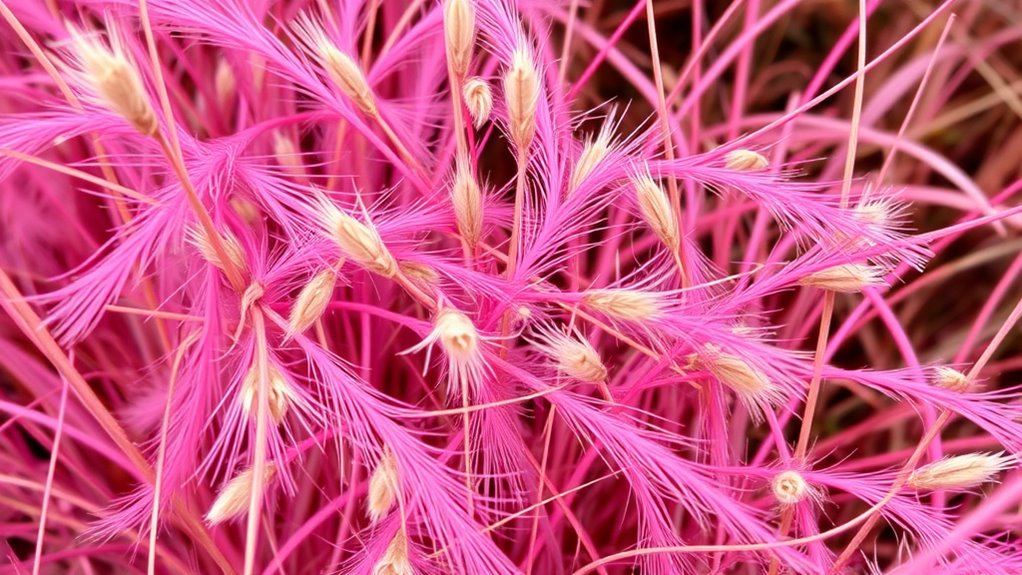
To protect your muhly grass during winter, start by applying a layer of mulch around the base to insulate the roots from freezing temperatures. This helps preserve color retention and keeps the plant healthy. To further shield your grass, consider these tips:
- Use burlap or wire mesh to prevent winter pests from settling on the foliage
- Trim dead or damaged stems to promote new growth in spring
- Water sparingly to avoid root rot, but make certain the soil isn’t completely dry
- Apply a slow-release fertilizer in early winter to support vitality
- Monitor for pests regularly and address issues promptly
These steps help maintain your muhly grass’s vibrant color and prevent winter-related stress or pest problems, ensuring it stays healthy and attractive year-round.
Frequently Asked Questions
Can Pink Muhly Grass Recover After Winter Browning?
If your pink muhly grass turns brown after winter, it can often recover, especially if the damage is from winter dieback and not disease. You should assess the plant’s soil drainage and confirm it’s well-draining, as poor drainage can worsen winter damage. Trim away dead foliage in early spring, and with proper care, the grass can bounce back. Patience and good soil conditions are key to revitalizing your muhly grass.
Is Brown Coloration Always a Sign of Disease or Death?
Have you ever wondered if that brown color change signals the end or just a seasonal shift? Brown doesn’t always mean disease or death; it can be winter dieback, especially for pink muhly grass. While the aesthetic impact might seem concerning, healthy plants often recover or prune away dead parts. So, assess the overall plant health before assuming disease—brown can be part of natural seasonal changes, not necessarily a sign of trouble.
How Often Should I Prune Muhly Grass for Health?
You should prune muhly grass once a year, ideally in late winter or early spring, to promote plant health. Establishing a consistent pruning schedule helps remove dead or damaged foliage and encourages fresh growth. Avoid over-pruning, which can stress the plant. Regularly pruning at the right time guarantees your muhly grass stays vibrant and healthy, preventing disease and keeping it looking its best throughout the season.
Are There Specific Fertilizers That Prevent Browning?
You’re wondering if specific fertilizers can prevent browning in muhly grass. To support healthy growth, follow fertilizer recommendations that promote a balanced soil nutrient profile, especially in the fall. Use a slow-release, low-nitrogen fertilizer to avoid excessive top growth that can lead to browning during winter. Proper fertilization helps maintain plant vigor, reducing stress and keeping your muhly grass vibrant and resilient through seasonal changes.
Can Pests Cause Browning in Pink Muhly Grass?
Pests can definitely cause browning in your pink muhly grass through pest damage or insect infestation. When pests feed on the grass, they weaken the plant’s health, leading to browning or dying back. You should inspect the grass regularly for signs of pests like aphids or mites. If you spot any, treat the infestation promptly with appropriate methods to prevent further damage.
Conclusion
Understanding the difference between natural winter browning and disease helps you care for your pink muhly grass effectively. Remember, studies show that over 70% of browning issues are seasonal and resolve in spring with proper care. By monitoring signs and providing the right maintenance, you can make sure your muhly grass stays healthy year-round. Don’t overlook small changes—early action can prevent more serious problems and keep your landscape vibrant and beautiful.


